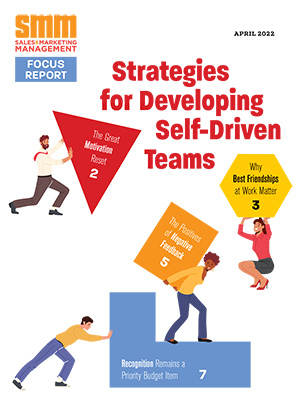While companies complain that 80 to 90 percent of their salespeople can’t sell value, they are spraying their salesforce with product presentations and praying that their salespeople will be able to figure out why customers should buy their product. But instead of complaining, companies should feel blessed that they can increase sales by capturing and sharing this valuable tribal knowledge with the rest of their sales force.
I recently sat through a new product presentation at the annual sales meeting of a major software company. As the head of product marketing blasted the salesforce with endless features, I was quickly flooded by way too much information. As I looked around the room, I felt enormous respect for the 10 to 20 percent of salespeople who would be able to do what few people in the company could. Armed with no more than a product presentation, these courageous sales superstars are able to walk into a C-level executive’s office, and provide the context needed for the executive to understand how they could use the salesperson’s software to solve their problems.
Selling Value is Getting More Difficult
One of these sales superstars recently shared a true story that showed just how hard it is today to sell value to today’s empowered buyers. He said: “Just last week before a meeting, a potential customer downloads, and then watches 11 videos on our CRM product. So by the time the meeting rolls around, the last thing this potential customer wanted was more information, because they’re drowning in it. All they wanted from the salesperson was insight into three key areas.”
Indeed, selling to today’s empowered buyers is demanding, and this is supported by a recent Gartner survey where 74 percentof executive buyers said that salespeople focus too much on their product, and only 34 percentfelt salespeople did a good job communicating business value.
These empowered buyers demand more because they have already done their research online. So by the time they engage a salesperson, they already know what they want, and the price they’re willing to pay. And when the seller’s product is complex, selling value is especially difficult, because customers lack both the time and expertise to form an accurate buying vision on their own. So if salespeople don’t challenge what customers have learned online with insight, then sales will be forced to follow the customer down the road of commoditization and discounting, because the customer has a limited view of the value of your product.
Value Selling Fail with Facts
But these sales stars know that delivering insight is more than just using data, facts and their brilliance to shock and awe buyers about the error of their ways.
Picture this. It’s 8:37 am, and one of your salespeople is on the elevator riding up to the 37th floor to see one of your largest potential customers. The 27-years old salesperson is about to sit at the boardroom table with a C-level executive with 25 years of experience, and deliver insight by teaching the executive the error of her ways. How do you think that conversation is going to go? I call this the “black eye and bloody nose” approach.
Value Selling Win With Stories
Instead of using a direct approach to deliver insight, star salespeople avoid conflict and use an indirect approach. By wrapping their sales insight up in a customer scenario, they are able to challenge their customer’s thinking without challenging the customer. Because these insight-based customer stories are about someone else, the customer won’t feel attacked. The story simply presents a scenario that allows the customer to draw their own conclusions. Without feeling pressured, the customer can now relax and listen to the message, and possibly gain enough insight that they start to tell themselves a new story, where new choices make more sense.
Sales stars are amazing because they are able to convert their product presentation into engaging customer stories so their customers can figure out why they should buy the salesperson’s product. According to the Gartner survey, 70 percent of executive buyers agree that “customer stories and case studies are the best way that providers can communicate differentiation that I trust.”
Stars Open Before They Close
Without a helicopter view of the customer’s world, you’ve probably noticed that your product centric salespeople are selling blind. When they do stumble upon a customer's pain point, for instance, they can only refer to vague pain points (i.e. “time consuming” or “prone to error”), because their knowledge of the customer’s world is superficial. The result is that product-centric salespeople are trying to rescue customers that are only ankle deep in problems. No wonder over 60 percent of sales opportunities end with the customer deciding to do nothing.
The sales stars, however, are able to clearly articulate what hell looks like without your product because they know before they can close the value gap for your product they first have to open it. These insight based stories open the value gap by providing a clear word picture of the before and after of owning your product. Because customers generally discount claims for gains, the salesperson must first help the customer to realize that they are not ankle deep in problems, but that they're really drowning in the middle of the lake before the customer is ready to see the value of being rescued by their product.
The good news is that your company can zero in on what are the insightful stories that your sales stars tell, and put them into a consistent format. Once completed, the rest of your team will now have the magic they need to inspire your customers to buy.
Michael Harris is CEO of Insight Demand,an insight selling sales training company. He also is the author of Insight Selling- Sell Value & Differentiate Your Product with Insight Scenarios


